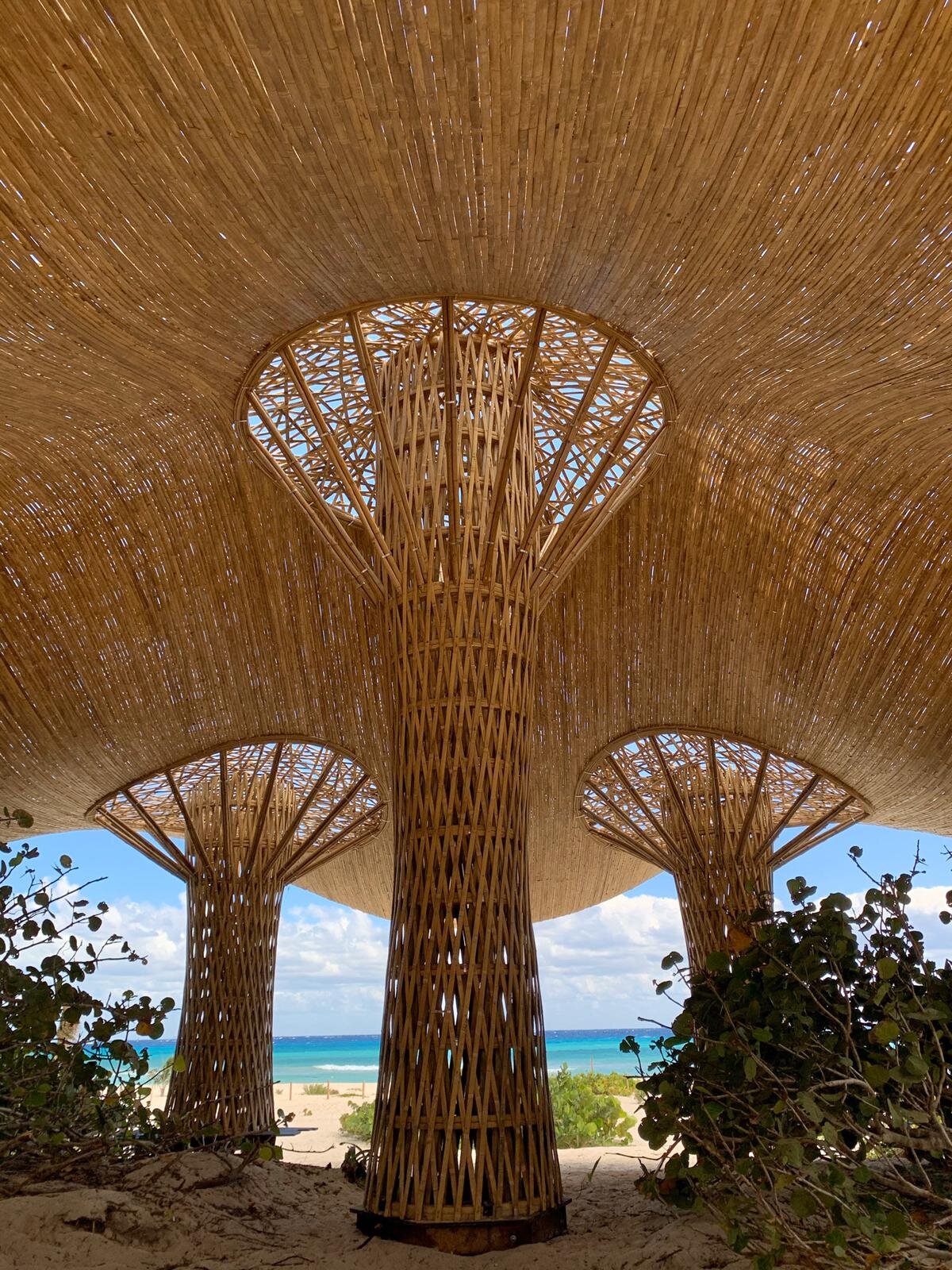Polo Pavilion, Sangay Architects
The first thing that caught my eye about this bamboo building was that it was serious in protecting its bamboo structure. This is still a rarity in the bamboo sector considering that bamboo (like timber) deteriorates when it is exposed to sun and rain. Sangay Architects practised good bamboo design by using tall plinths to lift the bamboo off the ground and applied generous roof overhangs to keep off sunlight and rain.
While this building has strong form and visual identity externally, it is the bamboo that glows and shines when we get inside and appreciate the structure and space created.
I start off this first Bamboo Building article in a ‘Q and A’ format which I hope works in providing the basic and necessary information required about the building and the designer/s. Please do visit the Sangay Architects website for more on their work and projects.
Thank you Kath Sapungay for taking the time to provide the answers and photos and for supporting Better Bamboo Building. Go Bamboo!
1. Describe the building and highlight its purpose and any special features
The building is a Polo Pavilion built in the 2019 SEA Games to host the VVIPs, namely the King of Brunei and Sultan of Malaysia. Luxury is often associated with reflective materials such as glass, gold and marble. Ironically, this Pavilion intended for the royal guests was made using Bamboo Poles for structural framing members, Bamboo Mat for the ceiling, Thatch roof and Stucco for the pedestal finish. We maintained the grandeur in scale to create a feeling of awe, and the clean repetitive and intricate patterns of the bamboo A-Frames harmoniously serve as both structural and aesthetic. The curves of the edges of the roof juxtapose the sharp edge of the triangular shape of the building.
2. What species of bamboo was used and how was it treated?
The species used in the project was Giant Bamboo. First, we had to consider to harvest only mature poles. We soaked the bamboo in a tub with running water to remove starch content. After the first batch of bamboo is dry, we dip it in chemical treatment to avoid powderpost beetles and termites.
3. Describe the design and pre-construction process for the building.
The timeline was quite a challenge because we were tapped to design and build this 4 months before the SEA Games. So while we were designing, we were simultaneously harvesting, treating the poles and training the people as well on what to do since bamboo construction is not yet that advanced in the Philippines.
As for the design part, we had to make sure that the digital model and lighting visualization was precise so that we can implement it accurately.
4. Who constructed the building and if you can elaborate on the construction process?
The building was constructed by Bambusa Construction Corp – a construction company specializing in bamboo construction and HMSanchez Builders. Given the limited time to build, the methodology was to work with the bamboo A-frames on ground simultaneously with the concrete pedestals where the bamboo will stand. And then when both concrete and bamboo are done, the A-frames were lifted by crane and fixed on top of the 3-meter high pedestal, creating a total height of 12meters.
5. Anything special or challenging that you want to share about the building in its design, construction process and maintenance?
The challenge for us was the knowledge transfer / learning curve of Filipinos. This is the first time we have used bolts and mortar connection in this scale. It did pay off though because as time went by, the workers got used to it and got faster.
Another is the distance of the bamboo source which was 140km to the construction site. There is not enough managed plantation of Bamboo in our place.
6. What would change or improve if you were to go through the process again?
What would improve for sure is the communication with people from the farmers to the workers doing the treatment to the construction workers. Bamboo Construction seems to have its own language when it comes to the process. Because more people have been trained and exposed to this type of construction, the work will surely be easier. But since we want to push Bamboo Architecture and Construction further, we want to try different techniques in every project. The next we’re eyeing for is using a metal hub for joineries.
7. Please provide some basic details of the building :
Building Details:
1. Name and purpose of building: MLR Polo Pavilion
2. Location: Calatagan, Batangas, Philippines
3. Floor Area: 375sqm
4. Cost: Confidential
5. Design and Construction time – 4 months (July - November 2019)
8. And anything else that you might want to add.
I’d like to emphasize the importance of managed plantation. Bamboo is versatile construction material that is easy to grow. In the Philippines, can now see that there is not much demand but there is a growing interest to use this material in the years to come. We may have enough resource today but if the demand rises and there is not enough managed plantation, people might just resort to natural stance and harvest negligibly. We want to keep building these beautiful buildings to make people aware of the beauty of bamboo but along with this we’d also like to emphasize the responsibility of builders towards the natural resources.
Ar. Kath Sapungay, RMP, PIA SANGAY ARCHITECTSMandaluyong, Metro Manila













